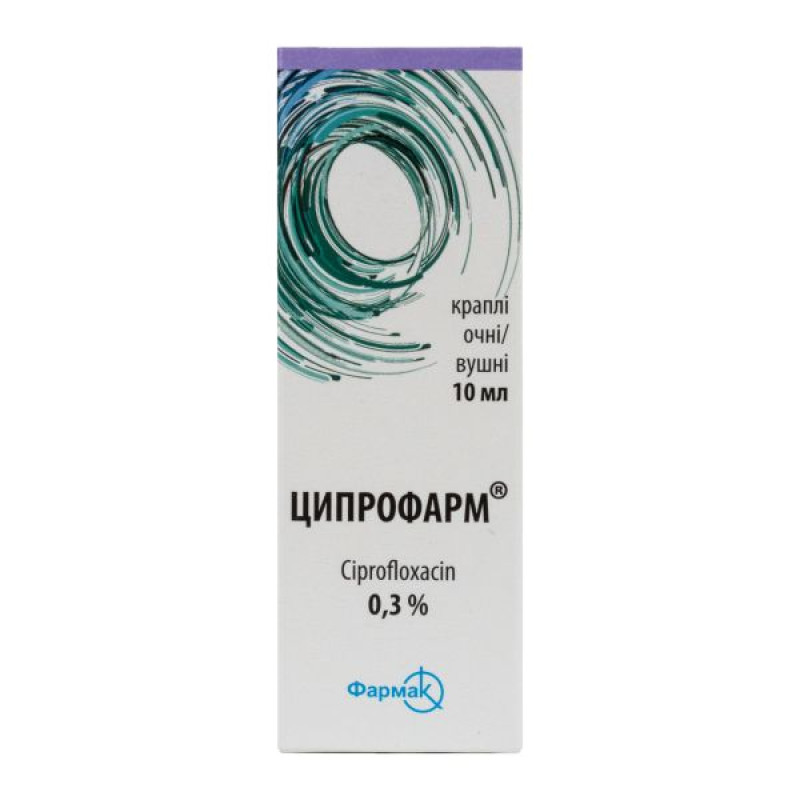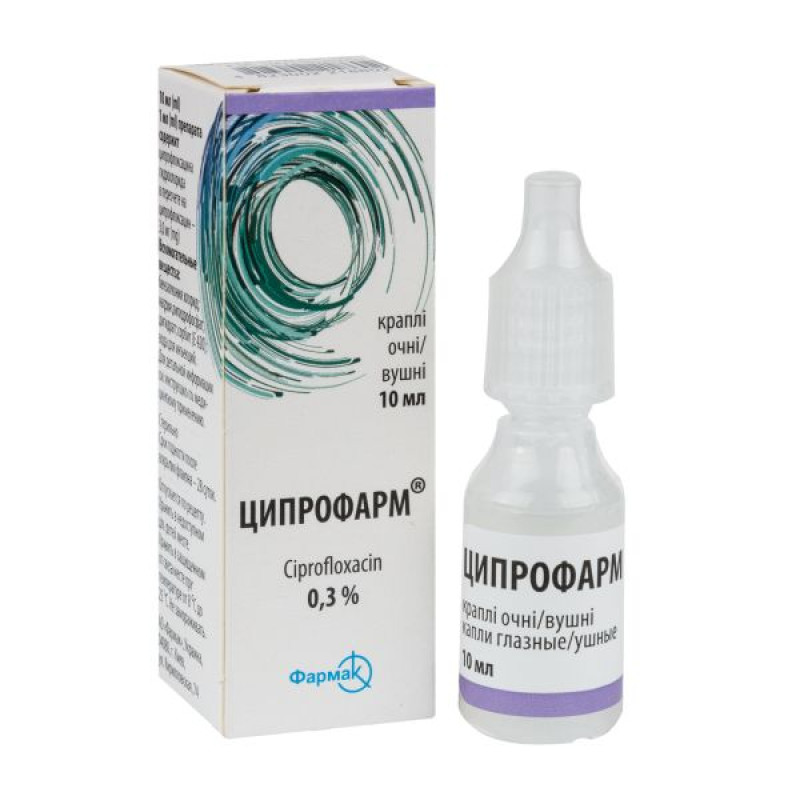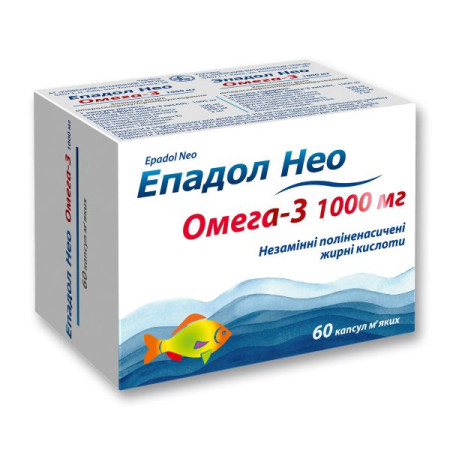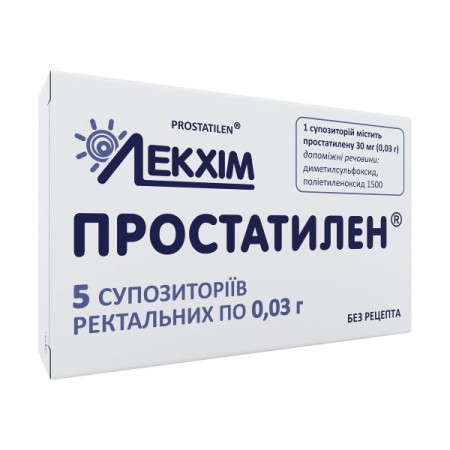Ciprofarm eye/ear drops 0.3% bottle 10 ml
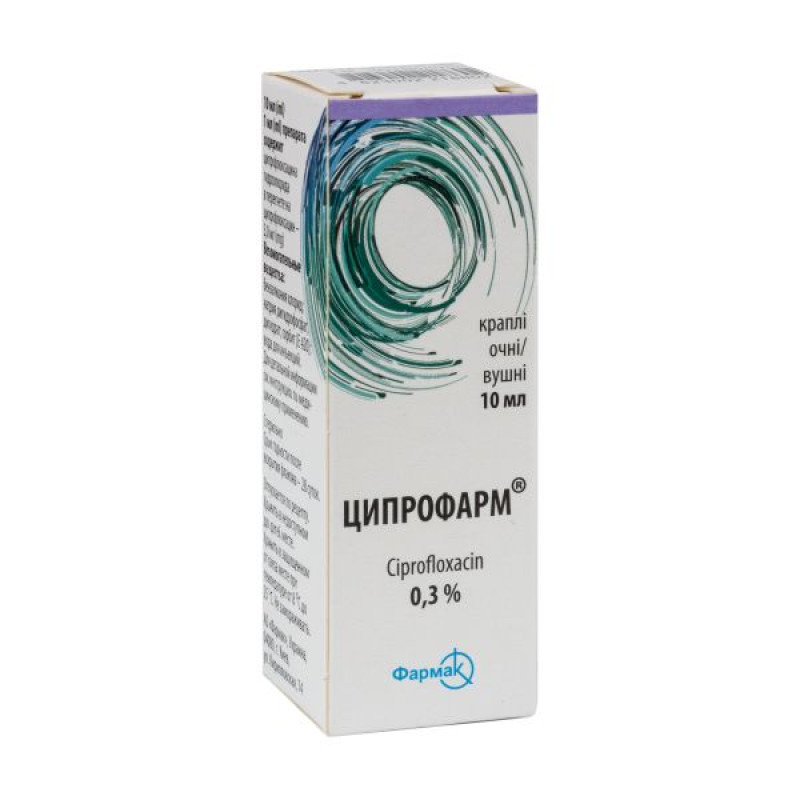
Instructions for use Ciprofarm eye/ear drops 0.3% bottle 10 ml
Composition
active ingredient: ciprofloxacin;
1 ml of the drug contains 3 mg of ciprofloxacin hydrochloride in terms of ciprofloxacin;
Excipients: benzalkonium chloride; sodium dihydrogen phosphate, dihydrate; sorbitol (E 420); water for injections.
Dosage form
Eye/ear drops.
Main physicochemical properties: transparent slightly yellowish-greenish liquid.
Pharmacotherapeutic group
Means for use in ophthalmology and otology. Antimicrobial agents.
ATX code S03A A07.
Pharmacological properties
Pharmacodynamics
Mechanism of action
Ciprofloxacin
Ciprofarm contains ciprofloxacin hydrochloride from the quinolone class. The bactericidal action of quinolones, which mainly affects bacterial DNA synthesis, is expressed by inhibiting DNA gyrase.
Ciprofloxacin has high in vitro activity against most gram-negative microorganisms, including Pseudomonas aeruginosa. It is also effective against aerobic gram-positive microorganisms, such as staphylococci and streptococci.
Sensitivity to microorganisms
Ophthalmic use
Ciprofloxacin is active against most strains of the following organisms.
Aerobic Gram-positive microorganisms: Staphylococcus aureus (including both methicillin-susceptible and methicillin-resistant strains); Staphylococcus epidermidis; Staphylococcus spp., other coagulase-negative Staphylococcus spp., including S. haemolyticus and S. hominis; Corynebacterium spp.; Streptococcus pneumoniae; Streptococcus of the Viridans group.
Aerobic Gram-negative microorganisms: Acinetobacter spp.; Haemophilus influenzae; Pseudomonas aeruginosa; Moraxella spp. (including M. catarrhalis).
Application in the ear
Ciprofloxacin has high in vitro activity against most aerobic Gram-negative microorganisms, including Pseudomonas aeruginosa. It is also effective against aerobic Gram-positive microorganisms, such as staphylococci and streptococci. As shown in the table below, ciprofloxacin demonstrates a broad spectrum of in vivo activity (MIC90S ≤2 μg/ml) against pathogenic microorganisms isolated from patients with acute otitis externa in recent clinical studies.
| Type of bacteria | Isolates N= | MIC(min) (μg/ml) | IPC(50) (μg/ml) | IPC(90) (μg/ml) | MIC(max) (μg/ml) |
| Pseudomonas aeruginosa | 1089 | 0.03 | 0.13 | 0.25 | 16 |
| Staphylococcus aureus | 221 | 0.13 | 0.50 | 1.0 | 128 |
| Staphylococcus epidermidis | 257 | 0.06 | 0.25 | 0.50 | 128 |
| Staphylococcus caprae | 75 | 0.13 | 0.50 | 0.50 | 2.0 |
| Enterococcus faecalis | 53 | 0.50 | 1.0 | 2.0 | 4.0 |
| Enterobacter cloacae | 45 | 0.004 | 0.016 | 0.032 | 0.25 |
Ciprofloxacin is also active against pathogenic microorganisms isolated from patients with acute otitis media with the use of tympanostomy tubes.
| Type of bacteria | Isolates N= | MIC(min) (μg/ml) | IPC(50) (μg/ml) | IPC(90) (μg/ml) | MIC(max) (μg/ml) |
| Streptococcus pneumoniae | 197 | 0.25 | 1.0 | 2.0 | 8.0 |
| Staphylococcus aureus | 134 | 0.06 | 0.25 | 1.0 | >128 |
| Pseudomonas aeruginosa | 132 | 0.03 | 0.25 | 0.50 | 128 |
| Haemophilus influenzae | 122 | 0.004 | 0.008 | 0.016 | 0.25 |
| Staphylococcus epidermidis | 103 | 0.06 | 1.0 | 64 | 64 |
| Moraxella catarrhalis | 37 | 0.008 | 0.03 | 0.06 | 0.06 |
| Escherichia coli | 15 | 0.008 | 0.03 | 128 | >128 |
Limit values of diameters of zones of inhibition of growth of microorganisms
Ophthalmic use
Ciprofloxacin has been shown to be active in vitro against most strains of the following microorganisms; however, the clinical significance of these findings in ophthalmic infections is unknown. The safety and efficacy of ciprofloxacin in the treatment of corneal ulcers or conjunctivitis caused by these microorganisms have not been established in adequate and well-controlled clinical trials.
The following bacteria are considered susceptible when assessed using systemic zone inhibition breakpoints. However, the relationship between systemic in vitro zone inhibition breakpoints and ophthalmic efficacy has not been established. Ciprofloxacin exhibits in vitro minimum inhibitory concentrations (MICs) of 1 μg/mL or less (systemic zone inhibition breakpoints) against the majority (90%) of the following ocular pathogens.
Aerobic Gram-positive microorganisms: Bacillus species.
Aerobic gram-negative microorganisms: Acinetobacter calcoaceticus; Enterobacter aerogenes; Escherichia coli; Haemophilus parainfluenzae; Klebsiella pneumoniae; Neisseria gonorrhoeae; Proteus mirabilis; Proteus vulgaris; Serratia marcescens.
Others: Peptococcus spp., Peptostreptococcus spp., Propionibacterium acnes, and Clostridium perfringens are susceptible microorganisms.
Insensitive
Some strains of Burkholderia cepacia and Stenotrophomonas maltophilia are resistant to ciprofloxacin, as are some anaerobic bacteria, especially Bacteroides fragilis.
Other information
Application in otology
Ciprofloxacin has been shown to be active in vitro against most strains of the following microorganisms; however, the clinical significance of these findings in ear infections is unknown. The safety and efficacy of ciprofloxacin in the treatment of acute otitis externa caused by these microorganisms have not been established in adequate and well-controlled clinical trials.
The following bacteria are considered susceptible when assessed using systemic zone inhibition breakpoints. However, the relationship between in vitro systemic zone inhibition breakpoints and otic efficacy has not been established. Ciprofloxacin exhibits in vitro minimum inhibitory concentrations (MICs) of 1 μg/mL or less (systemic zone inhibition breakpoints) against most (90%) strains of the following pathogens.
Aerobic Gram-positive microorganisms: Bacillus species; Corynebacterium species; Enterococcus faecalis; Staphylococcus aureus; Staphylococcus epidermidis; Staphylococcus caprae; Staphylococcus capitis; Staphylococcus haemolyticus; Streptococcus pneumoniae; Streptococcus of the Viridans group.
Aerobic gram-negative microorganisms: Achromobacter xylosoxidans subsp. chylosoxidans; Acinetobacter baumannii; Acinetobacter junii; Acinetobacter Iwoffi; Acinetobacter radioresistance; genospecies of Acinetobacter 3; Citrobacter freundii; Citrobacter koseri; Enterobacter aerogenes; Enterobacter cloacae; Escherichia coli; Haemophilus influenzae; Klebsiella oxytoca; Klebsiella pneumoniae; Moraxella catarrhalis; Proteus mirabilis; Pseudomonas stutzeri; Serratia marcescens.
Ciprofloxacin has also been shown to be active in vitro against most strains of the following microorganisms that cause otitis media:
Aerobic gram-positive microorganisms: Staphylococcus aureus; Staphylococcus epidermidis; Streptococcus pneumoniae.
Aerobic gram-negative microorganisms: Escherichia coli; Haemophilus influenzae; Moraxella catarrhalis; Pseudomonas aeruginosa.
Resistance to ciprofloxacin generally develops slowly. However, parallel resistance has been observed within this group of gyrase inhibitors.
Bacterial susceptibility testing has shown that most organisms resistant to ciprofloxacin are also resistant to other fluoroquinolones. The incidence of strains with acquired resistance to ciprofloxacin in clinical studies was low.
Due to its specific mode of action, there is no cross-resistance between ciprofloxacin and other antibacterial agents with different chemical structures, such as beta-lactam antibiotics, aminoglycosides, tetracyclines, macrolides and peptides, as well as sulfonamides, trimethoprim and nitrofuran derivatives. Thus, microorganisms resistant to these drugs may be sensitive to ciprofloxacin.
Pharmacokinetics
Ciprofloxacin is well absorbed after topical application to the human eye. Ciprofloxacin concentrations found in the tear film, cornea, and anterior chamber of the eye are ten to several hundred times higher than the MIC90 for susceptible ocular pathogens.
Systemic absorption of ciprofloxacin after topical ocular administration is low. Plasma ciprofloxacin levels after 7 days of topical administration ranged from unquantifiable (<1.25 ng/ml) to 4.7 ng/ml. The mean maximum plasma ciprofloxacin concentration obtained after topical ocular administration was approximately 450-fold lower than that observed after a single oral dose of ciprofloxacin, 250 mg.
In children with otorrhea with a tympanostomy tube or with a perforated eardrum, topical application of ciprofloxacin to the ear resulted in unquantifiable plasma ciprofloxacin concentrations at a detection limit of 5 ng/mL. In chinchillas, ciprofloxacin was distributed in plasma and middle ear fluid after intramuscular injection and absorbed into the inner ear after topical application to the middle ear.
The systemic pharmacokinetic properties of ciprofloxacin are well studied.
Ciprofloxacin is well distributed in body tissues, with tissue levels generally higher than plasma levels. The volume of distribution at steady state is 1.7-2.71 l/kg. Serum protein binding is 16-43%. The serum half-life of ciprofloxacin is 3-5 hours. After single oral doses ranging from 250 to 750 mg in adult patients with normal renal function, 15-50% of the dose is excreted in the urine as unchanged drug and 10-15% as metabolites within 24 hours. Both ciprofloxacin and its four primary metabolites are excreted in the urine and feces. The renal clearance of ciprofloxacin is generally 300-479 ml/min. Approximately 20-40% of the dose is excreted in the feces as unchanged drug and metabolites within 5 days.
Indication
Corneal ulcers and superficial infections of the eye(s) and its adnexa caused by strains of bacteria susceptible to ciprofloxacin.
Acute otitis externa, as well as acute otitis media with drainage through a tympanostomy tube, caused by strains of bacteria sensitive to ciprofloxacin.
Contraindication
Hypersensitivity to ciprofloxacin or to other quinolones, or to any of the components of the drug.
Interaction with other medicinal products and other types of interactions
Since ciprofloxacin has low systemic concentrations when applied topically to the eye or otolaryngology, interactions with other drugs are unlikely. If several topical eye medications are used simultaneously, wait at least 5 minutes between their applications. Ophthalmic ointments should be applied last.
Application features
Use in liver and kidney dysfunction.
The use of Ciprofarm in this category of patients has not been studied.
General
Serious and sometimes fatal (anaphylactic) hypersensitivity reactions have been reported in patients receiving quinolone therapy, some after the first dose. Some reactions have been associated with cardiovascular failure, loss of consciousness, tinnitus, swelling of the throat or face, dyspnea, urticaria, and pruritus.
Serious cases of acute hypersensitivity to ciprofloxacin may require emergency treatment. Oxygen therapy and airway patency should be administered as clinically indicated.
Ciprofloxacin should be discontinued at the first sign of skin rash or any other sign of a hypersensitivity reaction.
As with all antibacterial agents, prolonged use may result in overgrowth of antibiotic-resistant bacterial strains or fungi. In the event of superinfection, appropriate therapy should be administered.
Tendonitis and rupture are possible with systemic therapy with fluoroquinolones, including ciprofloxacin, especially in elderly patients and in patients receiving concomitant corticosteroid therapy. Therefore, treatment with Ciprofarm® eye/ear drops should be discontinued at the first sign of tendonitis.
Eye drops
Clinical experience in children under 1 year of age, especially newborns, is quite limited.
Ciprofloxacin eye drops are not recommended for use in newborns with neonatal blenorrhea of gonococcal and chlamydial origin, as such use has not been evaluated in this category of patients. Newborns with neonatal blenorrhea should receive treatment appropriate to their condition.
When using Ciprofarm eye drops, the risk of the drug entering the nasopharynx should be taken into account, which may contribute to the emergence and spread of bacterial resistance.
Ciprofarm eye drops contain benzalkonium chloride, which may cause irritation and discolor soft contact lenses.
It is not recommended to wear contact lenses while treating an eye infection.
Therefore, patients should be advised not to wear contact lenses during treatment with Ciprofloxacin eye drops.
Ear drops
The efficacy and safety of use in children under 1 year of age have not been evaluated.
When instilling into the ear, frequent medical monitoring should be carried out to allow for timely implementation of other therapeutic measures.
Ability to influence reaction speed when driving vehicles or other mechanisms
This medicine has no or negligible influence on the ability to drive or use machines. Temporary blurred vision or other visual disturbances may affect the ability to drive or use machines. If blurred vision occurs during instillation, the patient should wait until the vision clears before driving or using machines.
There is no data on the effect of Ciprofarm® ear drops on the ability to drive or use other mechanisms.
Use during pregnancy or breastfeeding
Reproductive function
Studies to assess the effect on reproductive function with topical application of Ciprofarm have not been conducted.
Pregnancy
There are no data on the use of Ciprofarm in pregnant women. Animal studies do not indicate direct harmful effects with respect to reproductive toxicity.
It is advisable to avoid the use of Ciprofarm during pregnancy.
Breast-feeding
Ciprofloxacin has been detected in breast milk after oral administration. It is not known whether ciprofloxacin is excreted in breast milk after topical application to the eye or ear. Ciprofloxacin should be used with caution in nursing women.
Method of administration and doses
Attention! Do not screw the bottle cap tightly before use! Before the first use, screw it as far as possible. In this case, the spike located on the inside of the cap pierces the hole. Immediately before use, hold the bottle with the drug in the palm of your hand to warm it to body temperature. Unscrew the cap, remove it and, slightly pressing on the bottle body, drip the solution into the eye. After instillation, screw the cap tightly and store the drug according to the recommendations given in the instructions. Eye drops should be used with maximum hygiene. Do not touch the edge of the dropper to any surface.
Application in ophthalmology
Dosage
Use in adolescents and adults, including elderly patients
Corneal ulcers:
on the 1st day, instill 2 drops into the conjunctival sac(s) of the affected eye(s) every 15 minutes for the first 6 hours, then 2 drops every 30 minutes for the first day; on the 2nd day, instill 2 drops into the conjunctival sac(s) of the affected eye(s) every hour; from the 3rd to the 14th day, instill 2 drops into the conjunctival sac(s) of the affected eye(s) every 4 hours.
In case of corneal ulcer, treatment may last more than 14 days; the dosage regimen and duration of treatment are determined by the doctor.
Bacterial superficial infections of the eye and its adnexa
The standard dose is 1-2 drops in the conjunctival sac(s) of the affected eye(s) 4 times daily.
For severe infections, the dose may be 1-2 drops every 2 hours for the first 2 days during the daytime.
As a rule, treatment lasts 7-14 days.
After instillation, tight eyelid closure or nasolacrimal occlusion is recommended. This reduces systemic absorption of drugs administered into the eye, which reduces the likelihood of systemic side effects.
In case of concomitant therapy with other topical ophthalmic drugs, an interval of 10-15 minutes should be observed between their use.
Use in children
The dosage for children over 1 year of age is the same as for adults.
A clinical study of newborns and children under 1 month of age found that Ciprofarm is clinically and microbiologically effective for the treatment of bacterial conjunctivitis in this category of patients when administered 3 times a day for 4 days.
Use in liver and kidney dysfunction
The use of Ciprofarm in this category of patients has not been studied.
Method of application
To prevent contamination of the dropper tip and solution, care must be taken not to touch the eyelids, surrounding areas, or other surfaces with the tip of the dropper bottle.
Application in otology
Dosage
Use in adults, including elderly patients
For adults, the dose is 4 drops of Ciprofarm in the ear canal 2 times a day.
For patients who require the use of ear plugs, the dose can be doubled only for the first use (i.e. 6 drops for children and 8 drops for adults).
In general, the duration of treatment should not exceed 5-10 days. In some cases, treatment can be extended, but in this case it is recommended to check the sensitivity of the local flora.
In case of concomitant therapy with other topical medications, an interval of 10-15 minutes should be observed between their application.
Use in children
The dose is 3 drops of Ciprofarm in the ear canal 2 times a day. The safety and efficacy of Ciprofarm have been studied in children aged 1 to 12 years. The safety and efficacy in children under 1 year of age have not been established.
Use in liver and kidney dysfunction
The use of Ciprofarm in this category of patients has not been studied.
Method of application
The external auditory canal should be thoroughly cleaned. To prevent vestibular stimulation, it is recommended to administer a solution at room temperature or body temperature.
The patient should be in a lying position on the opposite side of the affected ear. It is advisable to stay in this position for 5–10 minutes. Also, after local cleaning, a moistened gauze or hygroscopic cotton swab can be inserted into the ear canal for 1-2 days, but it must be moistened to be saturated with the drug 2 times a day.
To prevent contamination of the dropper tip and solution, care must be taken not to touch the auricle or external ear canal, surrounding areas, or other surfaces with the tip of the dropper bottle.
Children
Eye drops
The safety and efficacy of ciprofloxacin eye drops 3 mg/ml have been established in children aged 0 to 12 years. No serious adverse reactions related to the use of the drug have been reported in this category of patients.
Ciprofarm eye drops can be used in children from birth to treat bacterial conjunctivitis.
Ear drops
The safety and efficacy of ciprofloxacin 3 mg/ml ear drops have been established in children aged 1 to 12 years. No serious adverse reactions related to the use of the drug have been reported in this category of patients.
Safety and effectiveness in children under 1 year of age have not been established.
Ciprofarm ear drops can be used in children over 1 year of age.
Overdose
Given the characteristics of this drug, intended for external use, no toxic effect is expected when used in ophthalmology/otology at recommended doses, as well as in case of accidental swallowing of the contents of one bottle. In case of overdose of the drug Ciprofarm when applied topically to the eye, the excess drug should be washed out of the eye(s) with warm water.
Adverse reactions
Side effects observed after using Ciprofarm in the eye
Infections and infestations: barley, rhinitis.
From the nervous system: dysgeusia, headache, dizziness.
Ophthalmological disorders: corneal deposits, ocular discomfort, ocular hyperemia, keratopathy, corneal infiltrates, corneal discoloration, photophobia, decreased visual acuity, eyelid edema, blurred vision, eye pain, dry eye, eye swelling, eye itching, foreign body sensation in the eye, increased lacrimation, eye discharge, eyelid margin scaling, eyelid peeling, conjunctival edema, eyelid erythema, eye toxicity, punctate keratitis, keratitis, conjunctivitis, corneal dysfunction, corneal epithelial defect, diplopia, ocular hypoesthesia, asthenopia, eye irritation, eye inflammation, conjunctival hyperemia.
On the part of the organs of hearing: ear pain.
Respiratory, thoracic and mediastinal disorders: sinus hypersecretion.
Gastrointestinal: nausea, diarrhea, abdominal pain.
Skin and subcutaneous tissue disorders: dermatitis.
General disorders and administration site conditions: drug intolerance.
Laboratory tests: deviations from the norm of laboratory test results.
Adverse reactions reported with the use of Ciprofarm in the ear
From the nervous system: tearfulness, headache.
From the side of the organs of hearing and labyrinth: ear pain, ear congestion, otorrhea, ear itching, ringing in the ears.
Skin and subcutaneous tissue disorders: dermatitis.
General disorders and administration site conditions: hyperthermia.
Description of the listed adverse reactions
When topically applied fluoroquinolones, reactions such as generalized rash, toxic epidermolysis, exfoliative dermatitis, Stevens-Johnson syndrome, and urticaria have occurred very rarely.
In isolated cases, blurred vision, decreased visual acuity, and signs of drug residue have been observed when ciprofloxacin was applied to the eye.
Rarely, the components of the drug may cause a hypersensitivity reaction when applied to the ear. However, as with any substance applied to the skin, there is always the possibility of an allergic reaction to any of the components of the drug (for Ciprofarm ear drops only).
Serious and in some cases fatal (anaphylactic) hypersensitivity reactions, sometimes after the first dose, have been reported in patients receiving systemic quinolone therapy. Some reactions have been accompanied by cardiovascular collapse, loss of consciousness, tingling, swelling of the throat or face, dyspnea, urticaria, and pruritus.
In patients receiving systemic fluoroquinolones, tendon ruptures of the shoulder, hand, Achilles tendon, or other tendons requiring surgical repair or resulting in long-term disability have been reported. Studies and post-marketing experience with systemic fluoroquinolones indicate that the risk of such ruptures may be increased in patients receiving corticosteroids, especially in the elderly, and with high loads on the tendons, including the Achilles tendon. To date, clinical and post-marketing data have not demonstrated a clear relationship between the use of Ciprofloxacin and adverse reactions from the musculoskeletal and connective tissue.
In patients with corneal ulcers, frequent use of Ciprofarm has been associated with the development of a white precipitate in the eye (drug residue), which disappeared after continued use. The presence of a precipitate does not require discontinuation of Ciprofarm and does not have a negative impact on the clinical picture of the healing process.
Phototoxic effects of fluoroquinolones have been reported with systemic use. However, phototoxic effects of ciprofloxacin when applied topically to the eyes and ears are not typical.
Expiration date
3 years. Shelf life after opening the bottle is 28 days.
Do not use the drug after the expiration date indicated on the package.
Storage conditions
Store in a dark place at a temperature of 8°C to 25°C. Keep out of reach of children. Do not freeze.
Packaging
10 ml in a bottle. 1 bottle in a pack.
Vacation category
According to the recipe.
Producer
PJSC "Farmak".
Location of the manufacturer and its business address
Ukraine, 04080, Kyiv, Frunze St., 74.
There are no reviews for this product.
There are no reviews for this product, be the first to leave your review.
No questions about this product, be the first and ask your question.







